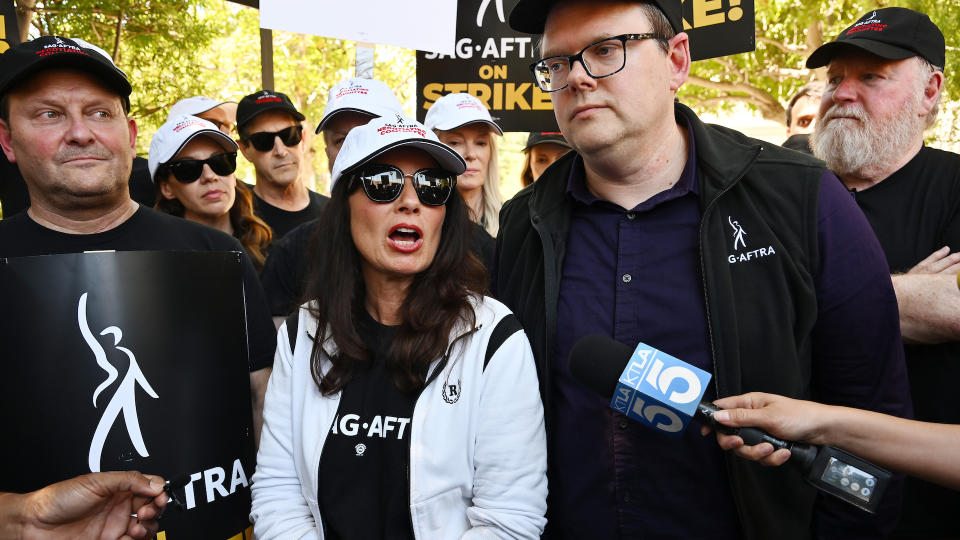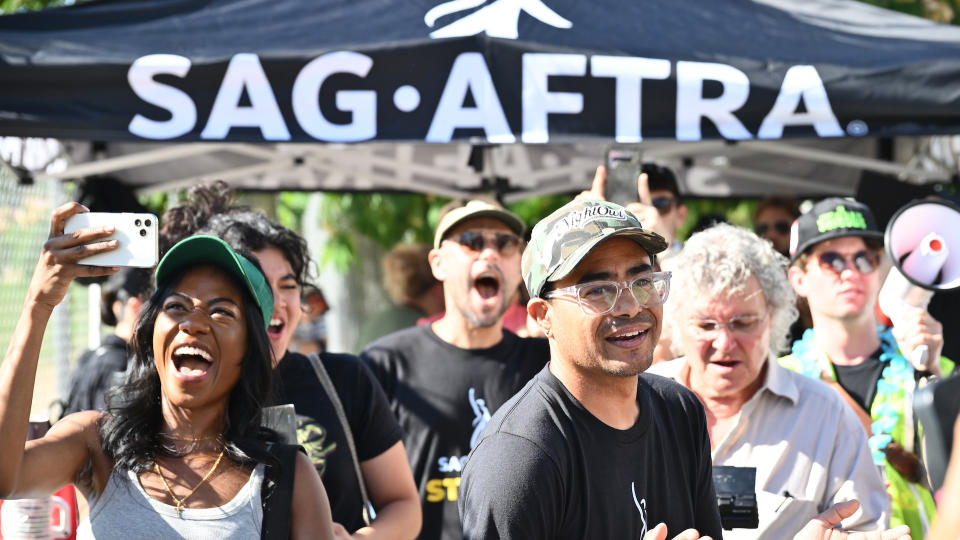Duncan Crabtree-Ireland Answers All Your Interim-Agreement Questions

Since the SAG-AFTRA strike began over two weeks ago, producers on more than 100 projects (and counting) received permission from the guild to continue working.
Most are independent films that were in the midst of production. Some have major stars attached; some are only approved to cast their films. A couple are indie TV series, and at least one production received permission to promote a film just before release.
More from IndieWire
Seann William Scott Had to Work as a Churro Guy at the L.A. Zoo After $8,000 'American Pie' Salary
SAG-AFTRA Insists Waivers for Indies Will Put More Pressure on AMPTP to Negotiate
That said: Why is Guy Ritchie casting a movie right now? Why is a Viola Davis movie that will be released by Amazon on the list? Is A24 really not in the AMPTP?
The questions got really loud over the weekend when Sarah Silverman said that working equals “scabbing,” interim agreements be damned. Davis then announced that even with an interim agreement, her project would not move forward at this time. Silverman softened her stance after a conversation with SAG-AFTRA leadership, and the guild finally put out a statement defending the interim agreements as a “vital part of our strategic approach” to negotiations with the AMPTP.
The guild emphasized that these productions do not operate under “waivers,” as popular shorthand would have it, but “interim agreements.” They aren’t a free pass: They mandate that the producers must agree to the same terms proposed to (and rejected by) the AMPTP. The guild is trying to prove that if indie producers can agree to their terms, why can’t major studios?
Even with all that, we still had questions.
IndieWire on Monday got on the phone with SAG-AFTRA National Executive Director and Chief Negotiator Duncan Crabtree-Ireland, who further cleared up confusion including the difference of those casting waivers, whether indie projects can get distribution during the strike, and how all of the above will impact the market for movies.
This conversation has been lightly edited for clarity.

IndieWire: What’s the distinction between the interim agreements for production or promotion and the newer ones specific to casting (listed in blue on productions list)? What was the reason for the separate designation?
Duncan Crabtree-Ireland: Really, there’s no difference. It’s the same interim agreement. Our normal process involves doing a bunch of things to prepare for a project to go live. Some of those things involve what we call financial assurances. That means protections that we put in place to make sure that when our members work, they get paid, that the company has the money that it needs to have, that all of the protections for both additional compensation and residuals are in place.
That’s a process that takes a while to put together. So once they’re on that list in any color, they have an interim agreement approved, and if it says casting in blue, that means they can start doing preliminary work like casting the project, but they can’t move forward with actually starting production until they’ve finished all of our paperwork and our steps for preparing a project to go live. So there’s no difference in terms of the interim agreement. It’s just what phase of completion their production is in.
Is that a problem that came about recently? Or did producers ask because they had projects that were in the middle of casting?
No, it’s that when we started this process, we were triaging to ensure that productions that were in the middle of producing will be the first ones [for which we approve agreements]. If there were cast on location, or if there was a project that was already shooting, it would minimize the disruption to that project. All of those projects were already cleared for work, obviously, because they were already in production. So the only issue for them was, are they or are they not eligible for an interim agreement?
With totally new projects, that’s not the case. With totally new projects, the first step is, are they eligible for an interim agreement? And if they are the next step is, now we need to do all the regular paperwork that’s involved in starting a new production with us to make sure our members are protected. So that’s the reason why at the beginning of this process, you only saw the first type, the black lines, and now as we are starting to approve some projects that are new, those will start out as blue where they can begin their early, pre-production activities. But they won’t move into production until we clear them and they are then reflected in black on that list.
Early on in the strike you said that the guild had received hundreds and hundreds of applications for interim agreements. Is that still the case? Are you still getting tons of applications sent in after the fact?
Yeah, we’re still getting a decent stream of applications for interim agreements, for sure. And we have received hundreds and hundreds of applications. I think the pace has regularized a bit compared to the first few days, but it’s still a substantial flow on a daily basis.
Are you still prioritizing projects that are in the works or are more imminent?
Anything where there’s a legitimate urgency to it. Obviously, the top of that list would be any ongoing project where members are on location, but I think those are probably all or almost all been addressed at this point. In addition, projects that are in production where there will be a particular economic impact.
From that point forward, we’re really just addressing projects in the order that they came in, bearing in mind that some projects take longer to approve than others because of the complexity of their ownership structures, the complexity of the chain of title of the project or the intellectual property rights. There’s a variety of factors that could impact how long it takes to clear them.

The Viola Davis project, “G20,” was one that started raising some concerns. Why was that project, which is being distributed by Amazon, qualified for an interim agreement or was it still considered a truly independent project?
Editor’s Note: “G20” is produced by MRC, which is not a struck company, and is only distributed by Amazon.
Well, I think rather than commenting on a specific project, I think it’d be better for me to just say that when we look at these projects, we’re looking at the entirety of the information behind them. We’re looking at things like who’s financing them, who has effective control over them, and who owns the intellectual property rights. And then for a small number of projects, there are other factors that are relevant, including if those projects are being produced outside the United States, whether there’s any legal issues attached to the jurisdiction they’re producing in (Editor’s note: That was the case with Apple TV+’s “Tehran”).
We take all of those factors into account and make a determination of what should and shouldn’t receive an interim agreement. The sole fact that there is a distribution deal with an AMPTP-related company is not in and of itself, the only determining factor. There are other factors that are weighed as part of that evaluation.
Companies that have signed an interim agreement for these independent films — are they still able to seek distribution, even with a streamer or AMPTP-affiliated company? What happens in that circumstance if they were to land a deal?
Provided that there’s no AMPTP involvement whatsoever on the production end, once they’re completely done, they can potentially seek distribution deals with AMPTP-related companies. But bear in mind that any distribution they do has to give full compliance with the terms of the interim agreement, including the new residuals provisions, the streaming revenue share proposal, and of course the expectation that those obligations are assumed by whomever they might transfer those those distribution rights to.
So how does that work? In the SAG-AFTRA statement released Sunday, it said “the terms of this agreement, particularly the streaming revenue share, will make distribution of these projects through AMPTP platforms unfeasible, until such time as an industrywide agreement has been reached,” but that “if and when an interim agreement project is distributed during the strike, the members will receive the full benefit of the improved terms of our agreement.” Is this a backdoor way of getting AMPTP companies to agree to some of these proposals if they wind up distributing these films?
That’s effectively what will happen. If they do distribute these projects in any platform, then they’ll have to do that in compliance with the residuals provisions and all the other provisions of the interim agreement. Whether it’s feasible, there’s a question as to whether it’s feasible for a streaming platform to take on one of these projects, because obviously the streaming revenue share proposal is part of that interim agreement, so they would have to be prepared to assume responsibility for making the streaming revenue share payments that are called for.
Is it unfeasible because the details haven’t been worked out yet, because or a third party hasn’t been agreed in terms of where that streaming data comes from?
No, the interim agreement does designate the third party as Parrot Analytics for the purposes of the distribution part of the equation. But when I say it’s not feasible or unfeasible for them, I think it’s more so because if the AMPTP companies are resisting the streaming revenue share proposal and refusing to engage on it or agree to it, then it seems improbable that their streaming platform would choose to assume the responsibility to make a payment under the exact proposal that they insist is impossible.

How do you expect that might impact the market as we approach the fall festivals like Toronto or Venice? Is that something producers you have spoken with have raised concerns about?
The concerns that have been raised have been more directed at whether they can participate in those festivals and marketplaces at all. I think there are lots of opportunities for feature films to find theatrical distribution, especially now. And of course, there’s nothing stopping a streaming platform from choosing to acquire a project. My guess is that they might acquire the project and not platform it until a deal was reached with the AMPTP. But really, that’s their choice. If they choose to platform it, that’s great. It just means they need to be in compliance with the streaming revenue share proposal, the residuals proposals, and other proposals that are part of the interim agreement.
So in that scenario, if the strike extends for a long period of time, if one of these interim movies that was being produced was bought and released — which seems unlikely, but depending on how long this goes — in that scenario, that movie would have to abide by these new terms and conditions, including streaming revenue sharing, however that’s going to work out?
Exactly. They would have to do that. Assuming the companies are all willing to do that, that’s great, because that was a deal we were prepared to make with the AMPTP until July 12, and to the extent that independent producers have made that deal with us by signing the interim agreement, and they go forward and carry out the distribution activities accordingly, that really just validates the practicality and the realism of that agreement.
Why was it important for you to to put out the statement Sunday night clarifying these and making the point that this is a “vital” part of your strategy in negotiations?
The negotiating committee and those of us that are in that part of the process have always been very clear about why we have interim agreements, why we think it’s a good strategy to have interim agreements, etc. I think we realized that there needed to be more communication directly to our membership about that. So many people were talking about it in the press and in other places that we were concerned the members weren’t hearing enough directly from us. That’s why it was important for the committee to put out the letter that they crafted, and we’ll be continuing to do more education and outreach to our members about interim agreements so that they understand them. Because I think they have the potential to feel complicated, and we want to make sure that people understand in a very straightforward way what the purpose of them is and why we have them.
Did the statement have anything to do with Sarah Silverman’s comments?
We spoke with Sarah on Friday night because, if you saw her video, it explicitly asked for someone to explain to her interim agreements. So we wanted to do that and just have that direct conversation, which we did do. From my point of view, the only linkage between that and anything else we did is just one piece of information that we had about some members not feeling like they had enough of a direct channel to why we were doing it and what the interim agreements are and why they’re useful. So I think that inspired us in part to really want to up that communication so that members have that information directly from their union, because obviously, the union is the best source for our members in finding out why we’re doing certain things and how we think that fits into our strategy.
Is there an update on what some of these movies at the fall festivals can expect? Are they going to have to wait until the 11th hour to find out if they can attend or promote their movies?
We have pretty extensive FAQs on our website that takes up that issue in particular. So I feel like people understand what it is they’re allowed to do and not allowed to, and obviously we can answer specific questions as they’re presented to us. But we’ve done multiple briefings with publicists, with agents, and lawyers to help make sure that everybody understands what the rules are and so no one is surprised by it. From my point of view, people do have that information, and we obviously continue to make sure that it’s out there so that everyone can be well informed and no one is taken by surprise.
Are you expecting many more projects to be added to the interim agreement list in the coming days or weeks?
I expect there to be more names added. I don’t know if I’d characterize it as a lot more. There will be continued approvals for interim agreements, so that list will definitely get longer. But it’s going to depend upon the level of interest from independent producers signing up for interim agreements and how many of them are sufficiently independent to get them. Like I said, we’ve got hundreds and hundreds of applications, so there’s a good chance that a decent portion of those will be approved.

Are you seeing, for the majority of these projects, that actors are returning to production and are willing to participate and get back to work?
I think actors are willing to participate when they are sure that what they are doing is consistent with what the union is asking them to do, and that participating actually furthers our strategy for the strike rather than impeding it. That’s part of why we wanted to make that case very clearly in the letter that the committee put out last night. Under those circumstances, actors are eager and willing to continue working in those types of productions.
It is worth noting that we have members working in a lot of other contracts areas as well like commercials, interactive, audio books, podcasts, music, videos, music contracts, broadcast contracts. We have many members working in other contract areas at all times. So it’s not foreign to our concept that there are members working under agreements that aren’t being struck.
Is there a universe where SAG-AFTRA would make a deal with one studio individually, separate of the AMPTP, in the way that the WGA made individual deals with different agencies during their during their packaging fees fight? Is that a possibility that the guild would negotiate on an individual level with as opposed to with the AMPTP at large if the strike got really extended?
Anything’s possible. I wouldn’t rule it out. However, I have no reason to think that that is likely or that’s going to happen. We already have a separate deal with Netflix, as you may know, which we re-negotiated last year, but they went out of their way to make sure that they could become part of the AMPTP and sync those agreements up. As of right now, I have no reason to think that could come to pass, but I wouldn’t rule anything out. Anything that helps us achieve a fair deal and help to keep the strike as short as possible would be something we’re interested in.
Are you expecting to come back to the negotiating table anytime soon?
I wouldn’t say expecting, but I definitely would say hoping. I tend to be an optimist, but I am optimistic that we will find some way to resume discussions with the companies, hopefully in the near future. From my point of view, the CEOs involvement in that conversation is going to be essential to there being an ability to find the path that breaks through the obstacles that have kept us from being able to reach a deal so far.
Best of IndieWire
Sign up for Indiewire's Newsletter. For the latest news, follow us on Facebook, Twitter, and Instagram.

